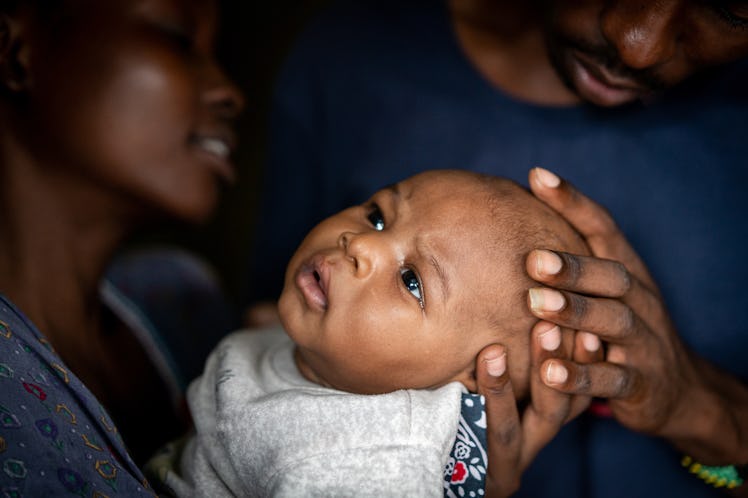What Parents Can (And Can’t) Learn From Babies’ Weird Head Shapes
From soft spots to flat spots, the shape of a baby's skull shape can give parents a lot of clues about how they're developing.

The birth of a child is a beautiful, unique experience that frequently ends with tears of joy and one simple, plaintive question: “Is the head supposed to look like that?” Babies’ weird head shapes when they first enter the world — oblong and vaguely alien — may be jarring, but they’re normal and no cause for concern. With vaginal birth specifically, a baby’s skull shape initially tells parents little beyond how cozy mom’s birth canal was. But as kids age, that changes.
“The head is often misshapen from the pressures of being born, so babies come out cone-headed and looking like little baby aliens,” says Kathleen Rowland, M.D., a physician and professor at Rush Medical College. These tiny coneheads’ skulls typically adjust on their own within 24 to 72 hours.
From there, an infant’s head shape starts providing clues if they have an underlying congenital issue or if they’re getting enough tummy time. Although phrenology, a popular 19th-century pseudoscience that claimed skull shape dictated aspects of intelligence and personality, is now regarded as unscientific, racist, and generally ridiculous, the same principles kind of work when applied to little kids. Just don’t think that you’re going to be able to use bumpology to locate a criminal impulse.
Most infants are born with soft spots, otherwise known as fontanels, which most parents know are not cause for concern. But these gaps in a baby’s skull, which close completely within two years, are not just normal — they’re necessary. The absence of them, a genetic condition known as craniosynostosis, does not allow enough room for the brain to grow and can result in a permanently misshapen head, as well as visual and sleeping impairments, challenges eating, and mental development problems including a low IQ. Craniosynostosis is relatively rare and affects only one out of every 2,000 to 3,000 children, according to estimates.
“If you don’t have soft spots, that’s a medical condition,” Rowland says. “The absence of soft spots is a big problem.”
It’s a great deal more common issue for babies to have heads that are flattened, typically on the back, a condition known as plagiocephaly. This occurs in up to half of infants, and rates have gone up in recent years as parents have learned to diminish SIDS risk by having babies sleep on their backs. Flat spots can form at any spot of the head (known as positional plagiocephaly), but frequently flatness occurs because infants are spending too much time on their backs outside of sleeping and not engaging in enough tummy time. Rowland explains that supervised tummy time not only helps babies develop their head, neck, and upper body muscles, but also helps their heads form a normal shape.
In some cases, parents have told Rowland that their babies hate tummy time, but there are plenty of things parents can do to make it more enjoyable for the child — the most effective being getting on the ground and on your stomach, too. It might feel stupid, but it’s meaningful for children who might want to someday wear hats.
Though there is some research suggesting kids with plagiocephaly have a greater risk of developmental delays, but studies are not conclusive. Helmets are sometimes used to treat this condition, but researchers are divided about whether they interfere with skin-to-skin bonding or if they work at all. Surgical treatment is more controversial, and doctors usually prescribe repositioning babies while awake so they’re not putting pressure on the flat side of the head.
It’s important to note that just because flatness is common doesn’t mean it’s normal. Rowland notes that parents shouldn’t assume a weird head shape is not a problem or that more tummy time is the solution. Flatness is sometimes a symptom of torticollis, another congenital problem with muscles in the neck that could make kids incapable of rotating their heads when they grow up. Whether it’s craniosynostosis, plagiocephaly, torticollis, or nothing at all, parents will be best positioned to make decisions if they share their concerns with their pediatrician.
There are ways to reduce the likelihood of a baby having a flat head, but it’s imperative for parents to be kind to themselves if and when it does happen, Rowland notes. In her experience, this represents the first time many parents encounter a “this is all my fault” moment. She recommends parents do their best to reframe this as an opportunity to practice the kind of resilience needed for raising kids.
“It’s a good chance to let go, forgive yourself, and roll with the ups and downs of parenting,” she says. “A baby may be ‘at risk’ for this, and at the same time, it isn’t all the parents’ fault. Sometimes it is just one of those things.”
This article was originally published on